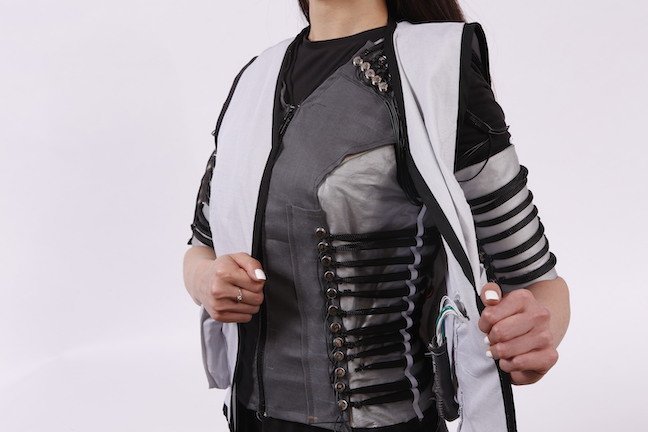CS&E researcher takes on artificial intelligence and shrinkable vests

Above: The Smart Hugs prototype vest.
Computer science professor Maria Gini is part of “Smart Hugs” team
Artificial intelligence (AI) has always fascinated Maria Gini. Since her undergraduate career, the College of Science and Engineering professor and computer science expert has loved finding mathematical models for complex ideas.
It wasn’t until she got involved with the University of Minnesota’s Grand Challenges Research Initiative that Gini realized AI could be a front for interdisciplinary solutions.
Now, Gini is collaborating with researchers Brad Holschuh of the University of Minnesota’s Wearable Technology Lab and Serguei Pakhomov of the University's Department of Pharmaceutical Care and Health Systems to develop Smart Hugs, a project that combines a compression vest, wearable biometric sensors, and an AI voice assistant with the goal of managing individuals’ stress and anxiety. Other University of Minnesota collaborators include Wilma Koutstaal, Michael Kotlyar, and Martin Michalowski.
While the biometric sensors will record data such as heart rate and body temperature, the advanced AI will communicate with the user and determine stress levels, which will ultimately result in an action via the compression vest. A hug is one example.
“For instance, if the AI sees that you are stressed, it can ask what is happening and what is concerning you,” Gini explained.
“And then eventually, the system will activate the vest for you," she said. "So maybe you’ll say, ‘I feel cold or lonely today,’ and it warms you up.”
Their project couples Gini’s computer science knowledge with Pakhomov’s linguistics research, which explores how medications and neurodegenerative disorders affect patients’ speech patterns. She said incorporating these two ideas could result in a more efficient, conversational AI assistant.
Collaboration is key
Smart Hugs is a part of phase three of the University’s Grand Challenges Research Initiative, in which six teams of faculty received a total of $1.95 million to fund two years of interdisciplinary research.
“AI has always been more looking at big problems, big ideas and big dreams,” Gini said. “You can do a lot of work in the individual discipline, but if you want to have an impact on the world, I think there always has to be more than one discipline involved.”
Gini said that although she has worked in AI nearly her entire career, she never thought of combining her technology with Pakhomov’s ideas about language processing.
“There’s a lot of evidence that diverse groups are much more productive than non-diverse groups, and you can think of that also in terms of research,” Gini said.
“You always generate different ideas together that you never think of directly because you’ve never come across those issues,” she added.
Gini believes her field of computer science has a lot to offer other subjects, mostly because of its strategies in “computational thinking.”
“In everything we do, we think what’s the input, what’s the output, what are the steps and how can we put them together,” she explained. “Not every discipline has this way of thinking, and I don’t think it’s very common outside of computer science. I think this is the part that is so critical to other disciplines.”
On the horizon
The Smart Hugs project is still in its preliminary phases, with researchers conducting tests to determine how a person’s speech reflects their biometric levels. Gini’s team is also working on how “human” the AI assistant should be.
For example: Would a patient with Alzheimer’s get confused talking to a device when there’s no person present? What kind of voice should be used? Gini said questions such as these must be answered before researchers can find the best solution.
Stress and anxiety management aren’t the only perks of this technology.
Gini said other applications could include calendar notifications and medication reminders for patients with Alzheimer’s or related diseases.
“We’re not thinking of something that would be used to cure people of things,” she said. “It’s more of a supplement or a support system.”
Gini thinks AI will become more and more relevant to the healthcare field in the future, especially as the cost of caring for the elderly rises.
“Having human support is the ideal, but if you don’t have that, what is the alternative?” Gini asked. “I think technology can provide a reasonable alternative. It may not be as good as a real person, but it can make life easier and more engaging.”
Story by Olivia Hultgren